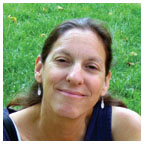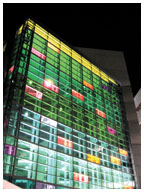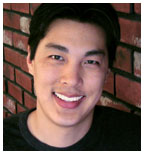March 7, 2007: Books and Arts
Documenting a year in the life
of a high school
Christopher Wong ’92 leaves banking for filmmaking
For a complete list of books received, click here.
Historian Martha Hodes *91 discovered hundreds of letters sent between a working-class white woman and her family. (courtesy Martha Hodes *91) |
Reading
Room
Crossing
the color divide
Martha Hodes *91 uncovers the extraordinary life of a Civil
War-era woman
By Iris Blasi ’03
While researching her dissertation on relationships between white women and black men in the 19th-century South, Martha Hodes *91 stumbled upon a Duke University collection of 500 letters sent between Eunice Connolly, a working-class white woman from New England, and her family. Because Connolly’s wasn’t specifically a Southern story, Hodes couldn’t use it, but she was intrigued by the woman’s remarkable decisions.
Born in Massachusetts, Connolly worked in a cotton mill until marrying at 17 and moving with her husband to Alabama in hopes he could find steady employment; instead, he joined the Confederate army. Seven months pregnant, Connolly, who supported the North, made the treacherous journey back to New Hampshire to give birth near her family. Then, widowed during the war and struggling to survive, Connolly married a well-to-do black sea captain, Smiley Connolly. By marrying across the color line and moving with Smiley to the West Indies, Eunice Connolly achieved the economic stability and status she always had desired.
 After
finishing her dissertation, Hodes couldn’t get Connolly’s
tale out of her head. Returning to Duke in 1997, she typed the letters
into her computer, and each chapter of the resulting biography, The
Sea Captain’s Wife: A True Story of Love, Race and War in the Nineteenth
Century, published by W.W. Norton in September, begins with one of
Connolly’s notes.
After
finishing her dissertation, Hodes couldn’t get Connolly’s
tale out of her head. Returning to Duke in 1997, she typed the letters
into her computer, and each chapter of the resulting biography, The
Sea Captain’s Wife: A True Story of Love, Race and War in the Nineteenth
Century, published by W.W. Norton in September, begins with one of
Connolly’s notes.
“I wanted Eunice’s voice, in some ways, to precede my own,” says Hodes, who earned a Ph.D. in history at Princeton and is an associate professor of history at New York University.
But the letters didn’t tell the whole story. There is a three-year period — when Eunice meets Smiley — that is absent from the letters; the correspondence may have been destroyed by a family member opposed to interracial marriage. Hodes traced Connolly’s journey, traveling from the Northeast to the Gulf Coast to the Cayman Islands and interviewing her descendants along the way. Hodes was unaccustomed to talking to her subjects. “I am a historian of the 19th century. I never imagined talking to the people I was writing about,” she says.
The woman who emerged from the research was, as Hodes writes, “an ordinary woman who led an extraordinary life by making momentous decisions within a world that offered her few choices.” In her letters, Connolly shares her hopes for her four children as well as her loneliness and despair.
History was the farthest thing from Hodes’ mind when she was a comparative religion major at Bowdoin College, but a work-study job in an archive at Harvard (where she went for her master’s in religion) redirected her academic life. “In my studies, I was working on ethereal ideas. At my job, I was working specifically with people’s lives and letters,” she says. She preferred the latter.
When asked what Connolly would think about being the subject of a book,
Hodes says, “Eunice never ever thought that her life was worthy
of a book.” She might have been embarrassed that anyone besides
her family had read the litany of what she believed to be the mundane
things she recorded, says Hodes. “Eunice wrote letters to her mother
in which she would say, ‘Please burn this after you’ve read
it.’” ![]()
Iris Blasi ’03 is a writer in New York City.
For a complete list of books received, click here.
 Green to Gold: How Smart Companies Use Environmental Strategy to Innovate,
Create Value, and Build Competitive Advantage — Daniel
C. Esty and Andrew S. Winston ’91 (Yale University Press). Drawing
on examples from companies like Toyota and Nike, the authors show how
corporations increase revenue by building environmental thinking into
their business strategies. Esty is a professor of environmental law and
policy at Yale. Winston is director of the Corporate Environmental Strategy
Project at Yale.
Green to Gold: How Smart Companies Use Environmental Strategy to Innovate,
Create Value, and Build Competitive Advantage — Daniel
C. Esty and Andrew S. Winston ’91 (Yale University Press). Drawing
on examples from companies like Toyota and Nike, the authors show how
corporations increase revenue by building environmental thinking into
their business strategies. Esty is a professor of environmental law and
policy at Yale. Winston is director of the Corporate Environmental Strategy
Project at Yale.
 Grindhopping: Build a Rewarding Career Without Paying Your Dues
— Laura Vanderkam ’01 (McGraw-Hill). The author, a freelance
writer in New York City, coined the term “grindhopping” to
describe what she has done since leaving college. In her book, she describes
how college graduates in their 20s can skip entry-level corporate jobs,
with their dull responsibilities and low pay, and dive right into more
creative and lucrative work by starting their own companies, freelancing,
or consulting.
Grindhopping: Build a Rewarding Career Without Paying Your Dues
— Laura Vanderkam ’01 (McGraw-Hill). The author, a freelance
writer in New York City, coined the term “grindhopping” to
describe what she has done since leaving college. In her book, she describes
how college graduates in their 20s can skip entry-level corporate jobs,
with their dull responsibilities and low pay, and dive right into more
creative and lucrative work by starting their own companies, freelancing,
or consulting.
 What Workers Want — Richard B. Freeman and Joel Rogers
*84 (Cornell University Press). The authors document workers’ attitudes
about participation and representation on the job. Workers want their
voices to be heard, a greater role in decision-making, and disputes to
be settled through arbitration, they say. Freeman holds the Herbert Ascherman
Chair in Economics at Harvard. Rogers is a professor of law, political
science, and sociology at the University of Wisconsin, Madison.
What Workers Want — Richard B. Freeman and Joel Rogers
*84 (Cornell University Press). The authors document workers’ attitudes
about participation and representation on the job. Workers want their
voices to be heard, a greater role in decision-making, and disputes to
be settled through arbitration, they say. Freeman holds the Herbert Ascherman
Chair in Economics at Harvard. Rogers is a professor of law, political
science, and sociology at the University of Wisconsin, Madison. ![]()
By K.F.G.
For a complete list of books received, click here.
(Photo by Christopher Janney ’72) |
Last month artist, architect, and composer Christopher Janney ’72
unveiled Rainbow Cove: Boston, a nine-story interactive sound and colored-glass
installation at Logan International Airport. Rainbow Cove Green, left,
was built in the northeast pedestrian tower as part of the airport’s
new central parking facility. As travelers move through the tower and
its elevators, they hear an ever-changing soundscore, titled “Sound
Environments of New England,” composed by Janney and played through
a 38-speaker array. Additional sounds are triggered by pedestrians pushing
elevator buttons. Complementing Rainbow Cove Green is Rainbow Cove Red
in the southeast pedestrian tower. ![]()
Christopher Wong ’92’s documentary, seen at right featuring principal Ed Tom, will be screened in New York City March 10. Above, Wong. (Photos courtesy Christopher Wong ’92) |
Documenting
a year in the life of a high school
Christopher Wong ’92 leaves banking for filmmaking
By Tamar Laddy ’94
When filmmaker Christopher Wong ’92 first crossed paths with Ed Tom, the subject of his forthcoming documentary Whatever It Takes, both men were on the fast track to financial success. The year was 1995, and Wong had parlayed his Princeton economics degree into a position at the Federal Reserve Bank of New York. Tom was an executive buyer at Saks Fifth Avenue.
Fast-forward 10 years to 2005. Wong, who by then had left banking to pursue a passion for film, got word that Tom had traded in his lucrative job to become a New York City public school teacher. When Tom was tapped to serve as principal of an experimental new high school, Wong sensed a story in the making.
Wong convinced his friend to allow him access to film the school’s inaugural year. Nine months and 100 hours of raw footage later, he emerged with the makings of a documentary that — while not quite finished — already is attracting the attention of festival programmers.
The Harlem Stage on Screen Festival (www.harlemstage.org) will screen a 12-minute clip of Whatever it Takes on March 10. Wong expects the final version of the documentary to run 80 minutes long. He hopes it will be completed by August.
In chronicling an academic year in the life of Tom’s school, the Bronx Center for Science and Mathematics, Wong saw an opportunity to shine a light on New York’s small-schools movement, an educational initiative that divides existing public schools into several smaller units, each with a particular academic emphasis.
From the beginning, Wong made it clear to Tom, who is still the principal, that he intended to show the school’s successes and failures. He and his crew followed students into their homes, providing an intimate look at the issues inner-city families face. And while the film captures Tom’s determination to see the students succeed, it also highlights the struggles of a teacher who is physically harassed by a student.
The Los Angeles-based Wong is largely self-taught as a filmmaker. He has paid his dues as a production assistant on various film sets. He worked his way up the ladder, picking up freelance camera and editorial work and taking film classes at Santa Barbara City College.
Whatever It Takes (www.whateverittakesdoc.com) is Wong’s first feature-length project. By working on a shoestring budget and promising his crew deferred payment, Wong was able to finance the filming with $11,000 in grants and donations.
“Coming out of Princeton, my goal was to make a million bucks
by the time I was 30,” Wong says with a smile. “Now, I just
want to raise $60,000 to finish the film.” ![]()
Tamar Laddy ’94 is a writer living in Los Angeles.




